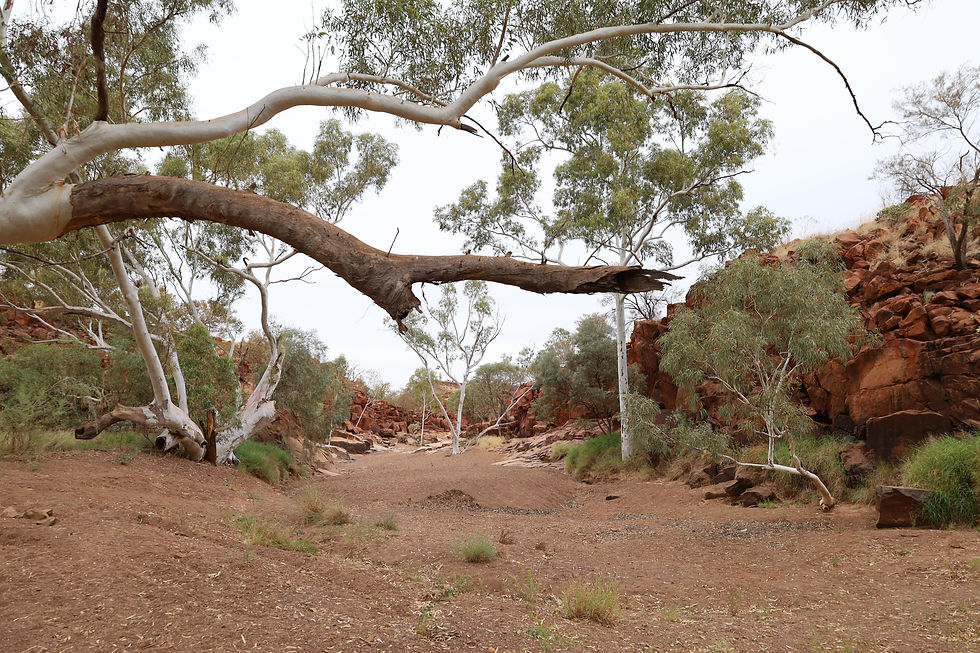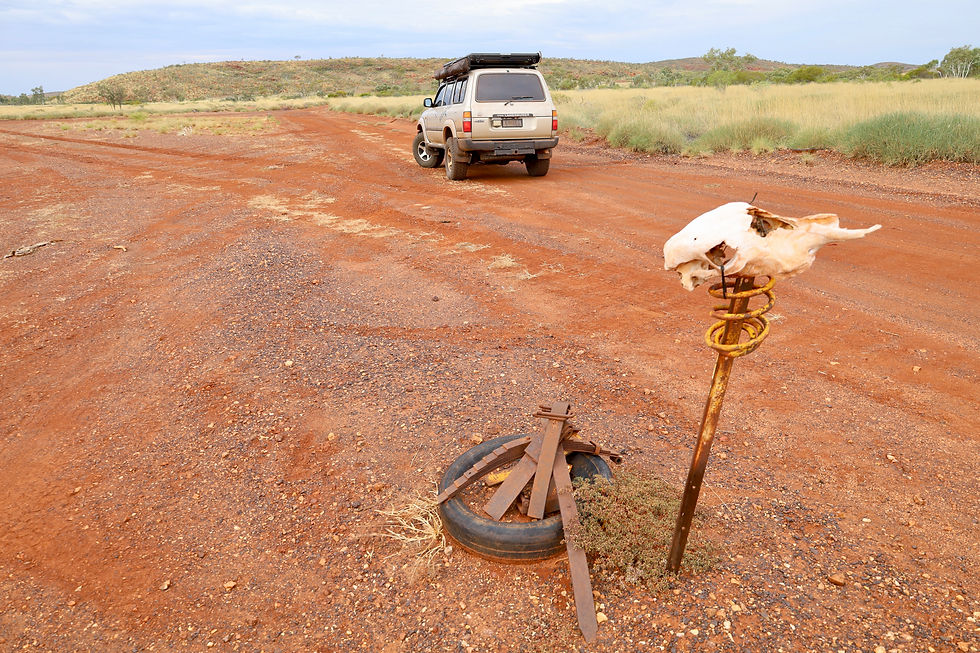NEWMAN to MARBLE BAR. Exploring the northern Pilbara region with its natural gems.
- Woolgoolgaoffroad
- Mar 25
- 6 min read
I had already spent a full three weeks exploring the southern regions of the Pilbara and believed I had seen everything until I took a last-minute detour through the northern areas. I was camping on the edge of the breathtaking and famous Karijini National Park, making my way towards the mineral-rich area of Newman, in central Western Australia.

My first stop was 80km before Newman to explore local rock art. Not signposted, it's an easy 4WD track to the parking area before a 10-minute walk up the small gorge that holds water in the wet seasons going by the white gums that are growing out of the red sand.

Wandering up through the rocky gorge and getting my eye in, I was stunned to see that these were petroglyphs ( art forms scratched into the rock as opposed to paintings ) and so many of them, by the Martu people. There are hundreds of them representing all types of native animals both common and unusual, weapons, there's different kinds of people, plants and some sort of enigmatic beings. It’s a quiet place where the more I looked the more I saw.

Down the road at Newman, the largest inland town of the Pilbara that has a normal population of around 5000 but doubles with FIFO workers is regarded as one of the most isolated and inhospitable places to work and live in summer. Hot winds blow off the Great Sandy Desert making temperatures soar yet in the cooler months nights often drop to 10*.
The town is based around the BHP mine of Mt Whaleback which is the largest open-cut mine in the world, there are bus tours in peak season into the mine and its processing area where the stats for the mine are staggering. It was in 1861 that explorer Francis Gregory led the first expedition through the Pilbara, and he reported that ore in the hills was playing havoc with his compass readings.

Small-time ore mining was taking place in the 1880s when a little gold was found around Nullagine and Marble Bar. The Pilbara was slowly developing around the coast area, but it was in 1957 that Stan Hilditch climbed a nearby mountain ( now called Mount Whaleback ) and realised that it was a massive ore deposit. Stan, his wife Elda and business partner Charles Warman kept the discovery quiet for several years while an embargo was in place. Work started in 1960 to start extracting the estimated 3 billion tonnes of ore, where massive trains carry the ore 430km to Port Headland for worldwide export.

Around Newman, there are also some pretty stunning areas to explore, like Cathedral Gorge on the way into Newman, plus Kalgan Pool and Eagle Rock Falls which is accessible only by 4WD. Kalgan Pool is known for its long drive up through a narrow track that’s underwater most of the year.

It’s a daunting drive where long grass brushes against your 4WD as you tackle the water track hoping no one will come the other way as you approach the corner midway. Out the other end, you’ll be rewarded with pristine and remote camping beside a deep pool where volcanic rock was pushed out of the ground millions of years ago.
A 30km hard 4wd track winds its way up and around the pool through spinifex country to the top of the plateau and further on to Eagle Rock Falls. This massive scar in the ground and deep falls must rage hard during the wet season dropping down into a gorge that has been cut over millions of years.


The track out of the falls continues through spectacular spinifex country where I saw multiple herds of wild Camels roaming around.

My next stop was Nullagine, a short-lived gold mining town that dates back to the 1880’s. Gold didn’t last long here but when the rush was on there were a reported 3 pubs, 8 stampers and nearly 4000 people.

Interestingly this was the first place in Australia where diamonds were found in 1902, as well as a host of other precious stones. Today, it's a quiet well-kept town with only a handful of locals, but visitors can spend time enjoying the remoteness and Nullagine’s natural attractions, like Conglomerate and Beatons Gorge, cool off at Daylight Pool or wander around town and admire the relics.
I was told about a stunning camp location and waterhole called Skull Springs ( also known as running waters ), and when I head out of Nullagine for 120km I would definitely know where the turn was. Not ‘officially’ signposted as such, but an animal skull stuck on a 4WD spring, I soon found the turn and headed down the track towards the waterhole.

Only accessible by high clearance 4WD to the sweet spot, where warm water seeps out of the ground from underground springs, it’s a beautiful and magical spot, where the water is turquoise blue with Paperbark Trees lining its bank. The long pool is crystal clear for its entire length and with body temperature water it was a perfect place to spend a few hours, with a perfect camping area high up on the bank surrounded by spinifex hills.
The next morning I headed up along the Upper Carawine Gorge 4wd track where it eventually crossed one of the local creeks, and while it was their dry season the crossing was relatively easy with a stoney bottom. One of my goals was to find a place called Carawine Gorge that I was told about and just how special it was, where camping beside the waterway was some of the best in the Pilbara region.
It wasn’t long before I found the turn to the gorge along Woodie Woodie Road with ancient mesa rock formations in the far distance. Arriving at Carawine Gorge, it blew me away where campsites faced the massive waterway and where a huge rock wall lined the far side. I was lucky to snag a grassy site ( mind you there’s about 5km of free sites to find beside the water ) with a fireplace and where the previous campers left a sack of seasoned wood.

It’s a peaceful and serene place to camp where the afternoon fading light brings out the true Pilbara colours across the spinifex grasslands. There had been a few light showers in the area the previous days and with the spinifex grass coming to life it was a magical sight, especially the next morning when the sun lit up the rock walls reflecting across the water.

The next day I headed further on towards Marble Bar, 170km away to see if the rumours were true about being Australia’s hottest town. The drive to town is true Pilbara style with stunning scenery across its massive plains towards weathered down mountains that have taken millions of years to get to where they are today. It was back in 1924 that Marble Bar got the reputation as the hottest town when for 161 days the temperature never dropped below the magic 100*.
Today, Marble Bar is a quaint quiet place, but according to records it emerged as a town when gold miners were passing through to different areas. Gold was found nearby in 1891 and this created a small rush for the town, swelling the population to over 5000, but by 1905 miners left for the extremely rich field south at Kalgoorlie. Government offices were built, pubs popped up, ( namely the Iron Clad Hotel which now is heritage listed ), stampers were installed and then during WW11 a massive airstrip was built for the US and AUS bombers along with a machine gun nest.

Today the buildings are heritage listed and it's a popular destination for travellers in WA wanting to see this iconic town and visit the nearby rock bars. Originally thought to be seams of marble running through rocks, it turned out to be the highly colourful Jasper rock across the Coongan River.
It was here in the mining days that the Chinese set up gardens and used the water for market gardens to feed the miners in the goldfields. Huge fines are in place if Jasper is removed from the area. A visit to Australia’s hottest town isn’t complete without visiting the nearby Comet Gold Mine which boasts the highest smoke stack in the southern hemisphere.
This whole adventure surprised me across the gorgeous Pilbara country, with history from town to town, amazing camps and waterholes to relax in, throw in some 4wding and exploring stunning ancient artwork, it seems the Pilbara just keeps giving to those who explore more.

WHERE
Bordering the Great Sandy Desert, this part of the north Pilbara has a lot to offer in between massive mining operations and remote areas. Newman to the south, caters for the mine workers and tourists, while Marble Bar to the north is known as the hottest town in Australia, but it's what’s in between that can keep anyone busy exploring.
WHAT TO SEE AND DO
Learning mine history and rock geology, camping throughout the northern Pilbara in stunning and remote locations, discovering ancient Aboriginal petroglyphs to driving some of the best 4WD tracks in the area, there is plenty to see and do in this northern pocket. There are swimming holes in the area such as Upper Carawine Gorg, Skull Springs and running waters.

OTHER INFO
As always a lot of info can be found online, but Newman and Marble Bar have comprehensive tourist information centres. At Nullagine, Marble Bar and Newan there are tourist signs at local POIs,s and along walking trails.
































































ความคิดเห็น